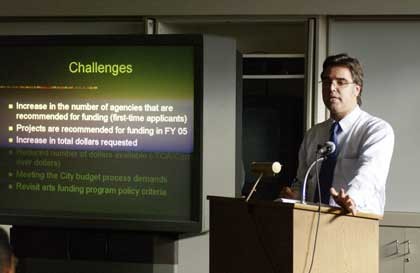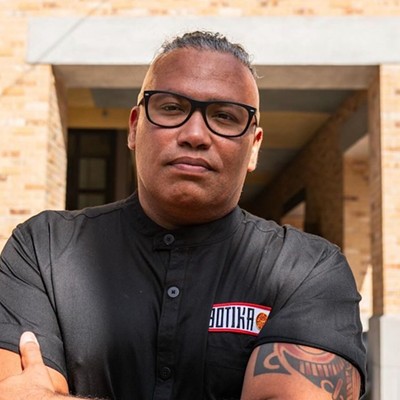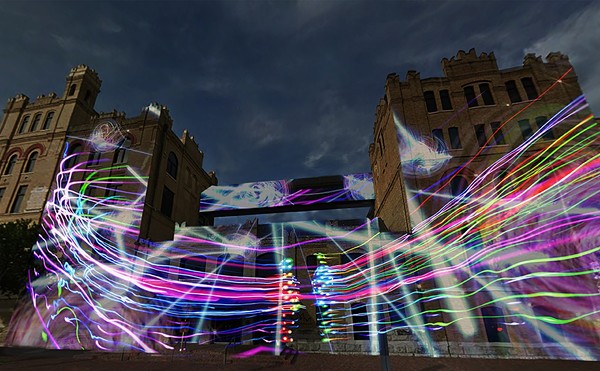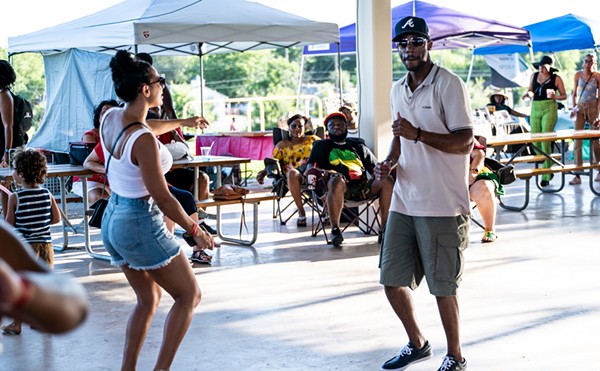OCA proposes a new funding process, but some arts groups are already shooting holes in it
On a recent sunny September morning, a wiry young man with a bowl haircut was painting This is not Art in bright red, 3-foot-high cursive lettering below Anton Vidokles installation of large, multi-colored graphic symbols on the old Lacks building at San Pedro and I-35 North downtown. Another man, pulling a wheeled suitcase and looking a little down on his luck, stopped to engage the ersatz critic in a lively conversation, both men gesticulating and laughing, and drivers streaming past the exchange rubbernecked for a view of the rush-hour diversion. Less than a day later, the objection had been more-or-less erased with white paint.
| Felix Padrón, director of the Office of Cultural Affairs, addresses the attendees at a 2004 Cultural Arts Board funding meeting. OCA has just released a draft of new arts-funding guidelines developed by CAB in reponse to criticism about peer panels and other issues. (Photo by Mark Greenberg) |
Art is often controversial, as is arts funding, but it was not nearly as entertaining to watch the latter in process during the 2004 budget cycle, when many local organizations took their funding cuts almost unavoidable with a static pool of money and a growing group of applicants personally. The meetings of the Office of Cultural Affairs Cultural Arts Board, the group responsible for making the final funding recommendations to City Council, frequently turned into heated confrontations in which the members were accused of devaluing San Antonios Latino and Chicano heritage and a member of the panels that evaluated the applicants for CAB was accused of exercising a vendetta against the Esperanza Center.
Despite considerable acrimony between OCA, the Westside Arts Coalition, which represents Esperanza among other organizations, and applicants such as Blue Star Contemporary Art Center who felt validated (read: received a funding increase), at the end of the day all sides agreed that the process itself was flawed. In response, this spring CAB began to redesign the funding-application process, and last week, OCA mailed an outline of the proposed changes to local arts organizations to solicit feedback. In order to be in place for the next funding cycle, which begins in January 2006, a new process must be approved by Council no later than the beginning of December.
Yet early responses from some of the organizations most upset by the 2004 process indicate that OCA and CAB are not going to achieve an easy consensus. Many of the hot-button issues have been addressed: Panel members will be selected earlier and receive training by the National Endowment for the Arts or a similar professional organization; the three evaluation panels, previously divided by discipline, will be collapsed into one to eliminate panel scoring disparities (last time around, multi-disciplinary scores were lower overall, which put those applicants at a disadvantage compared to the visual and performing arts); and panelists will be required to make site visits, an element of the evaluation process that was optional in previous funding cycles. But other proposed funding guidelines are raising red flags among applicants.
The CAB proposal suggests using funding-request limits to level the playing field between large, established institutions such as the San Antonio Museum of Art and smaller, community-based organizations such as Urban-15. Organizations with a budget greater than $1 million must match any City funds three-to-one in cash only. If SAMA receives $250,000, it must show that it has $750,000 in additional cash income. Organizations whose budgets fall between $50,000 and $100,000 need only match their City funds one-to-one, and 50 percent of those matching funds can be in-kind, which includes pro-bono legal work and food and beverage donations. Applicants who fall in the middle range, the largest group, must match City funds two-to-one and only 25 percent of their match can be in-kind.
CAB also recommends capping the percentage of an organizations budget that can come from City funds. The largest institutions can request no more than 10 percent of their proposed operating budget; the smallest can request only 20 percent; and those in the middle tier, which includes Esperanza, may request up to 25 percent.
But Esperanza Executive Director Graciela Sanchez is concerned about these restrictions. I havent had a chance to start knocking down numbers, `but` were probably `going to be` getting less than what were getting now, she says. The cap on in-kind contributions, in particular, she adds, can hurt small and mid-size cultural groups. Maybe someone cant give you $120, but they find other ways to give. Its a good way to show how the community is committed to our organization.
| OCA Director Felix Padrón says that one of the main goals of limiting in-kind contributions is to foster financial stability and cash flow. |
Sanchez argument is echoed by the Texas Commission on the Arts, the state mechanism for arts funding. In addition to enhanced matching capabilities, in-kind donations demonstrate to funders that people in your community value your organization, says the website. Applicants for TCAs panel grants, which are comparable to OCAs operating-funds grants, can use up to 50 percent in-kind contributions to meet their required funding match.
OCA Director Felix Padrón says that one of the main goals of limiting in-kind contributions is to foster financial stability and cash flow in smaller and fledgling organizations. Through the heated 2004 debates and this years redesign, Padrón has maintained that his goal is to professionalize the process and make quality programming the main focus of the evaluation. Artistic Merit still comprises 40 percent of applicants panel scores, and while there will now be only one panel comprised of four members for every 12 applicants, each panelist will be required to visit at least three organizations to evaluate their programming and outreach.
This element of the proposed changes directly addresses some of the concerns expressed by the applicants, but many, if not most, of the proposal reflects OCAs desire for a smoother, less contentious process. Applicants appeals of their panel scores would be in writing only, eliminating a step that was particularly vitriolic last time around. If it doesnt violate the Open Meetings Act, Padrón also would like CAB to deliberate over panel and staff recommendations behind closed doors. Its not a frank conversation when the public is there, he says.
That desire is unlikely to sail quietly by Esperanza, Centro Cultural Aztlán, and the rest of the Westside Coalition, who have insisted on complete access to the arts-funding process and want, in fact, more transparency in the redesign. When that initial process was created under (former Cultural Affairs Director) Eduardo Diaz in the late 80s or early 90s, I think all the arts organizations sat in on the talks, says Sanchez. Now were just getting to respond to their proposed changes.
CAB included community input by asking Centro Executive Director MaLena Gonzalez-Cid and Southwest School of Art & Craft President Paula Owen to represent the applicants during CABs discussions. Im just one voice and I could offer my experience based on my organization, says Gonzalez-Cid, but theres not a cookie-cutter pattern for all the other organizations.
Owen, however, felt positive about the redesign when she spoke with the Current earlier this summer. Anyone whos ever given money away knows how hard it is and how important the process is, and especially for it to be as transparent as possible and as fair as possible, she said, but I like the process, and `CAB Chair` Ruby `Perez` has been doing a great job of keeping it business-like and inclusive, but moving it along `but` Im sure itll get much tougher further on because well get down to the details.
Now the details are public, and the next few weeks will tell how tough, or not, it will be for CAB and OCA to put a new arts funding process in place. •
|
Highlights of proposed new The Office of Cultural Affairs will create the Arts Funding Division, which will award funds in three categories: The General Operating Program and the Neighborhood Arts Program will run on the same two-year funding cycle, rather than alternating as they do now. The NAP will follow the guidelines and application of the AIC program. Funding levels will be capped based on projected budgets: The ratio of matching funds and the use of in-kind contributions for matching funds will be limited: Applications: Peer-panel review: Evaluation: Applicants will be scored on the following criteria: Source: City of San Antonio, Office of Cultural Affairs |
By Elaine Wolff
For a series of stories on the 2004 funding process, see The runaway panel, August 19-25, 2004, Clear as mud, July 1-7, 2004, and Bottom line blues, June 24-30, 2004.


















